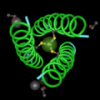iGEM is all about synthetic biology, kids. It's the annual International Genetically Engineered Machine competition.
Each team in the IGEM competition has to make something using a kit of biological parts from the Registry of Standard Biological Parts. Teams of students use these parts to design, build, and operate biological systems in living cells.
IGEM began in 2003 with a course at MIT where students made cells blink. Now, this year had:
- 1200 participants,
- 84 teams,
- and 24 awards.
Amazingly, two of those awards went to a team (UCSF) composed mostly of students from a public high school in San Francisco, Abraham Lincoln High.
I've written about their teacher, George Cachianes, before, and he is inspirational.
What did this team to win the Best New Application award?
They made a system that would silence specific genes in baker's yeast, Saccharomyces cerevisiae. They took a protein that modifies chromatin structure and devised a method to control its activity.
You can read more about the UCSF project here.
And see all the winning teams and participants!
- Log in to post comments



Just to let your readers know that Andor Technology plc are running a competition for the scientific community. $400 to the charity of your choice, will be awarded for the winning entry in the 2008 Christmas Card design contest, plus the opportunity to promote your work on http://www.andor.com - Check out:
http://www.youtube.com/watch?v=k85yzCSdhrc